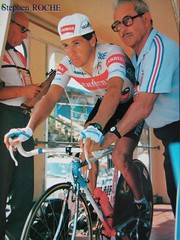- Jul 28, 2009
- 898
- 0
- 0
I would like to draw your attention to the following recently published scientific article which may  D) be relevant to the Clinic. I have posted the abstract below and here is a link to pubmed if you have full text access to the journal.
D) be relevant to the Clinic. I have posted the abstract below and here is a link to pubmed if you have full text access to the journal.
http://www.ncbi.nlm.nih.gov/pubmed/20473822
I'm just reading it myself and will probably comment a bit further once I finish.
Tour de France, Giro, Vuelta, and classic European races show a unique progression of road cycling speed in the last 20 years. El Helou N, Berthelot G, Thibault V, Tafflet M, Nassif H, Campion F, Hermine O, Toussaint JF.
J Sports Sci. 2010 May;28(7):789-96.
Abstract
Road cycling ranks among the most intense endurance exercises. Previous studies and mathematical models describing road cycling have not analysed performances per se. We describe the evolution of road cycling performance over the past 116 years. We studied the top ten cyclists' mean speeds in eight famous classic races and three European Grand Tours, using a previously published multi-exponential model that highlights the different progression periods of an event during the century. In addition, we measured an indicator of difficulty for the Tour de France by calculating the climbing index (i.e. the total altitude climbed over total distance). The eleven races' mean speed increased progressively from 23.13 km . h(-1) in 1892 to 41.19 +/- 2.03 km . h(-1) in 2008. Road cycling development, like other quantifiable disciplines, fits a piecewise progression pattern that follows three periods: before, between, and after the two World Wars. However, a fourth period begins after 1993, providing a speed progression of 6.38% from the third one. The Tour de France's climbing index also provided insight into a recent paradoxical relationship with speeds: when the climbing index increased, the winner's speed also increased. Our results show a major improvement (6.38%) in road cycling performance in the last 20 years and question the role of extra-physiological parameters in this recent progression.
http://www.ncbi.nlm.nih.gov/pubmed/20473822
I'm just reading it myself and will probably comment a bit further once I finish.
Tour de France, Giro, Vuelta, and classic European races show a unique progression of road cycling speed in the last 20 years. El Helou N, Berthelot G, Thibault V, Tafflet M, Nassif H, Campion F, Hermine O, Toussaint JF.
J Sports Sci. 2010 May;28(7):789-96.
Abstract
Road cycling ranks among the most intense endurance exercises. Previous studies and mathematical models describing road cycling have not analysed performances per se. We describe the evolution of road cycling performance over the past 116 years. We studied the top ten cyclists' mean speeds in eight famous classic races and three European Grand Tours, using a previously published multi-exponential model that highlights the different progression periods of an event during the century. In addition, we measured an indicator of difficulty for the Tour de France by calculating the climbing index (i.e. the total altitude climbed over total distance). The eleven races' mean speed increased progressively from 23.13 km . h(-1) in 1892 to 41.19 +/- 2.03 km . h(-1) in 2008. Road cycling development, like other quantifiable disciplines, fits a piecewise progression pattern that follows three periods: before, between, and after the two World Wars. However, a fourth period begins after 1993, providing a speed progression of 6.38% from the third one. The Tour de France's climbing index also provided insight into a recent paradoxical relationship with speeds: when the climbing index increased, the winner's speed also increased. Our results show a major improvement (6.38%) in road cycling performance in the last 20 years and question the role of extra-physiological parameters in this recent progression.








